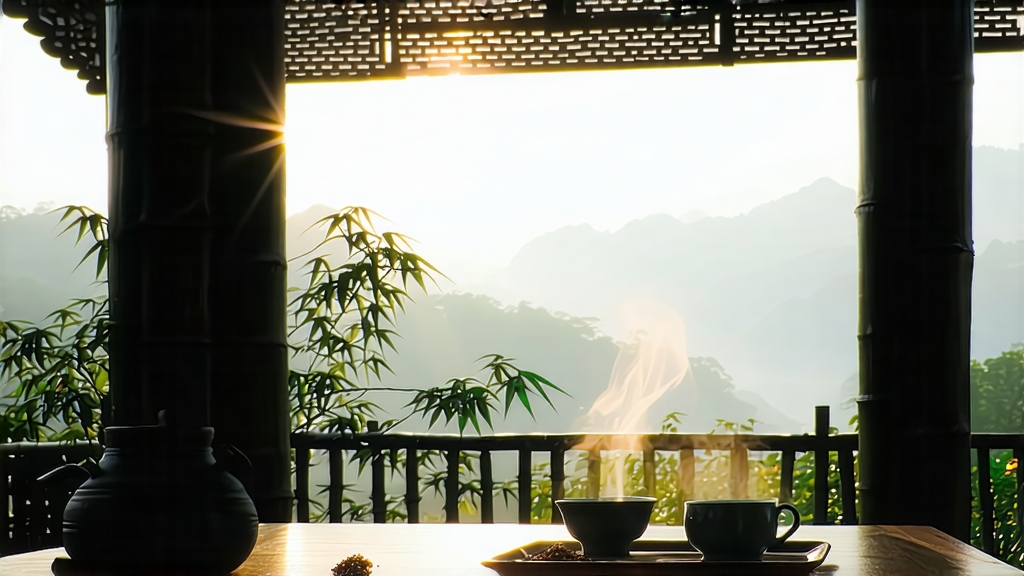
Alishan High-Mountain Oolong belongs to the prestigious family of Taiwanese high-mountain teas, yet it stands apart for the way morning clouds, cedar forests, and volcanic soils converge in every curled leaf. Internationally it is often labeled simply “Alishan Oolong,” but within Taiwan the tea is affectionately called “Alishan Qing Xin,” a nod to the Qing Xin (literally “green heart”) cultivar that has adapted to elevations between 1,000 and 1,400 m since the 1970s. The story begins when the Taiwanese Tea Research and Extension Station released Qing Xin cuttings to farmers who, barred by law from planting rice on steep slopes, turned to tea. They discovered that the slower growth at altitude condensed flavor compounds, while the diurnal swing of 10 °C or more locked in a signature milky-jade fragrance. Thus a frontier crop became a cultural icon, carried overseas by travelers who tasted it in Chiayi night markets and never forgot the lingering orchid note.
Although Alishan is a single mountain range, the tea is not monolithic. Micro-lots vary by township—Fengqi, Shizhuo, Zhongpu—and by season. Winter harvests, picked in mid-October when the northeast monsoon arrives, yield a crisper, more mineral cup, whereas spring teas, plucked in early May after gentle April showers, are rounder and more floral. Some farmers experiment with light bug-bitten harvests in summer, producing a honeyed iteration reminiscent of Oriental Beauty yet still framed by high-mountain freshness. Purists divide Alishan Oolong into three oxidation styles: modern “light aroma” (15–20 %), traditional “medium green” (25–30 %), and a rare “amber” (35–40 %) revived by heritage craftsmen. Each style is a lens on the same terroir, proving that place and craft dance together.
The crafting begins at dawn when pickers select the standard “one bud two leaves,” still dewy and cool. Leaves are first solar-withered on large bamboo trays for 20–30 minutes, softening cell walls and initiating enzymatic activity. Indoors, they undergo repeated tossing in tumbling drums—eight to twelve cycles over four hours. This bruises edges just enough to invite oxidation while keeping the leaf center green, the hallmark of partial oxidation. When the leaf emits a unmistakable orchid-cream aroma, oxidation is halted by a high-temperature tumble in a gas-fired drum set at 280 °C for ninety seconds, a Taiwanese innovation that locks in fragrance without scorching. Rolling comes next, but unlike the tight dragon-ball style of Dong Ding, Alishan leaf is gently strip-rolled into dark-green commas, preserving the integrity of the high-altitude cell structure. A low-temperature bake at 80 °C for six hours reduces moisture to 3 %, yet the final charcoal session is brief—only 30 minutes over longan wood—to avoid masking the pristine mountain qi. The finished tea rests for forty days, allowing residual flavors to marry before market release.
To brew Alishan Oolong well, one must respect its dual nature: hardy enough for altitude, yet delicate in fragrance. A 120 ml gaiwan or small unglazed clay teapot is ideal. Use 6 g of leaf—about two heaping tablespoons—rinsed quickly with 95 °C water to awaken the rolled curls. The first infusion, 45 seconds, releases a pale jade liquor with a lifted bouquet of white freesia and fresh cream. Subsequent steeps lengthen by ten seconds, revealing a layered profile: snap pea sweetness, a hint of pine resin, and a finish that echoes alpine air. By the fifth infusion the leaf has fully unfurled, showing intact burgundy edges against emerald centers, proof of skillful oxidation control. Cold brewing is equally rewarding: 8 g of leaf in 500 ml spring water, refrigerated overnight, yields a luminous champagne-colored infusion with a silky mouthfeel and a lingering melon note, perfect for summer terraces.
Professional cupping follows a quieter rhythm. Warm the tasting set, add 3 g of leaf, and inhale the dry aroma: it should suggest magnolia and whipped butter, never green grass or roasted nuts. After the first 3-minute infusion, examine the liquor color under daylight; top-grade Alishan glows like light chardonnay, never straw yellow. Slurp vigorously, aer